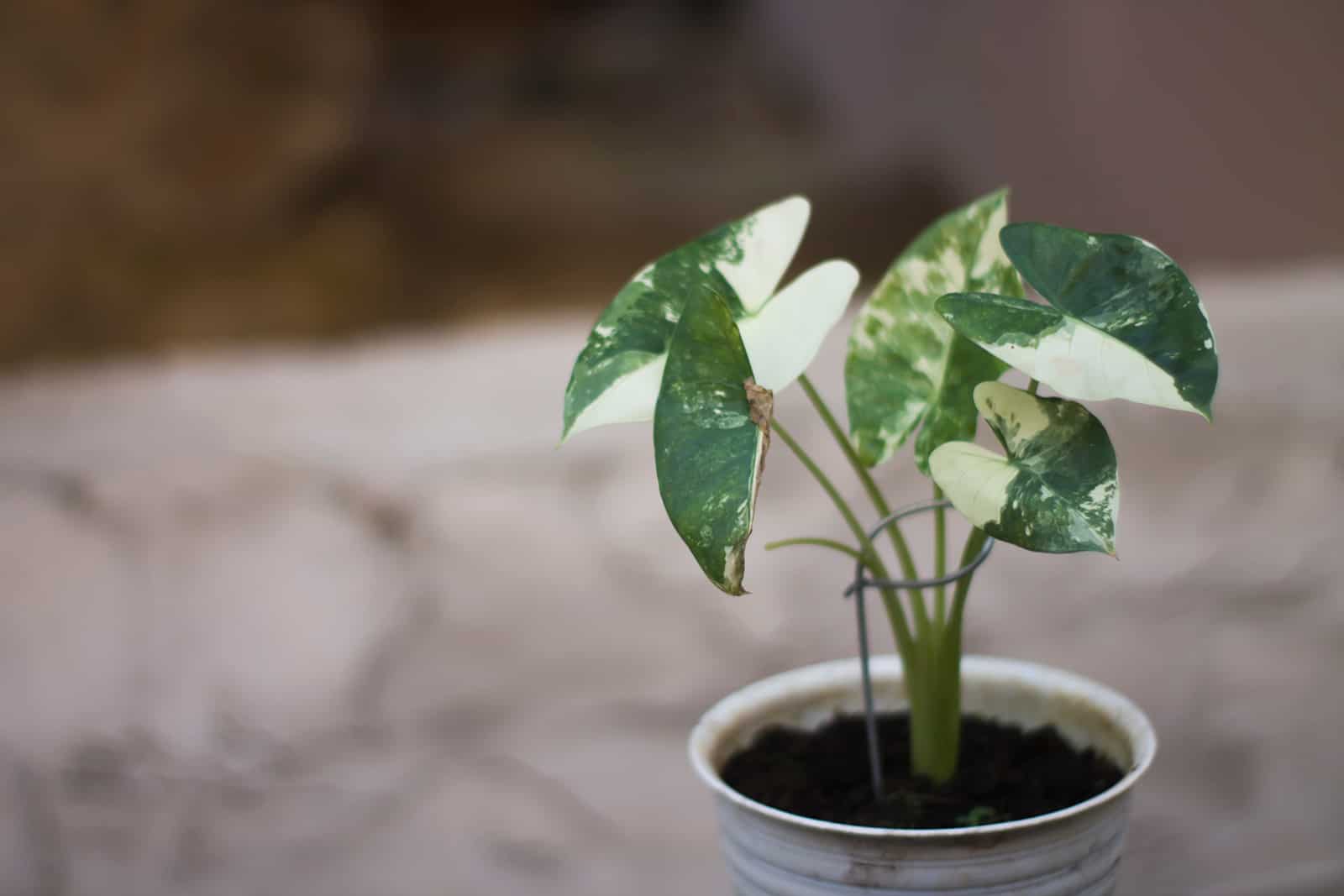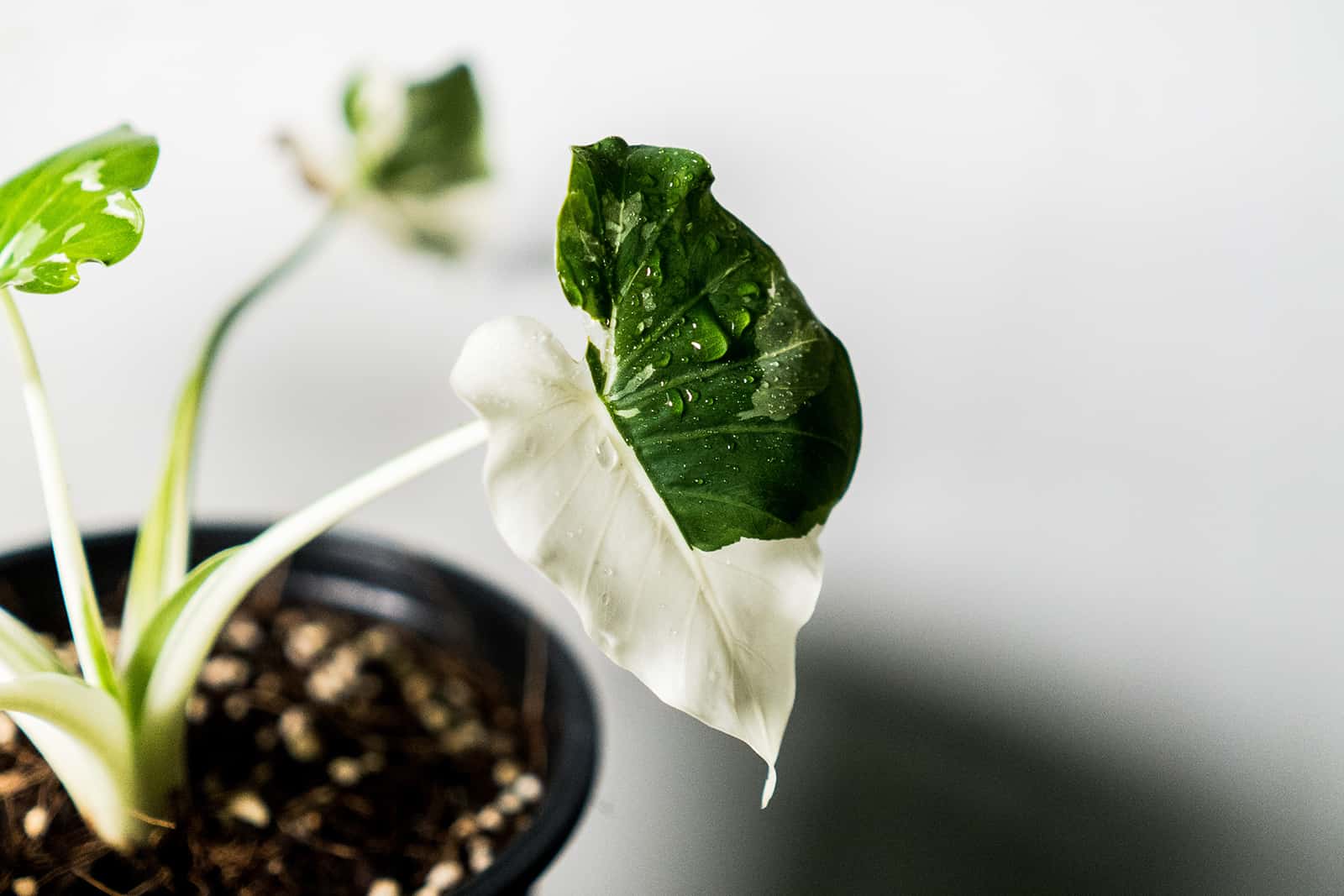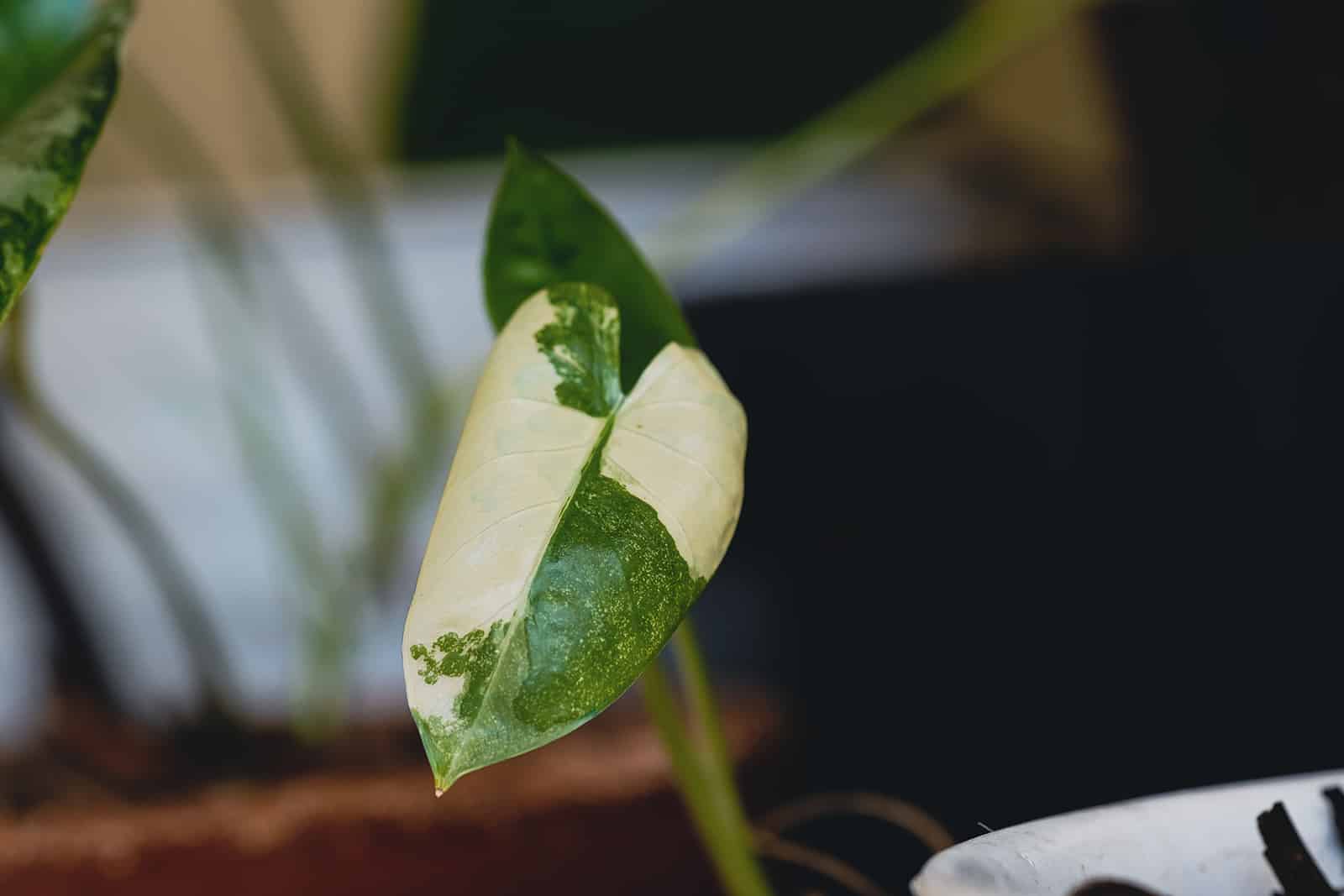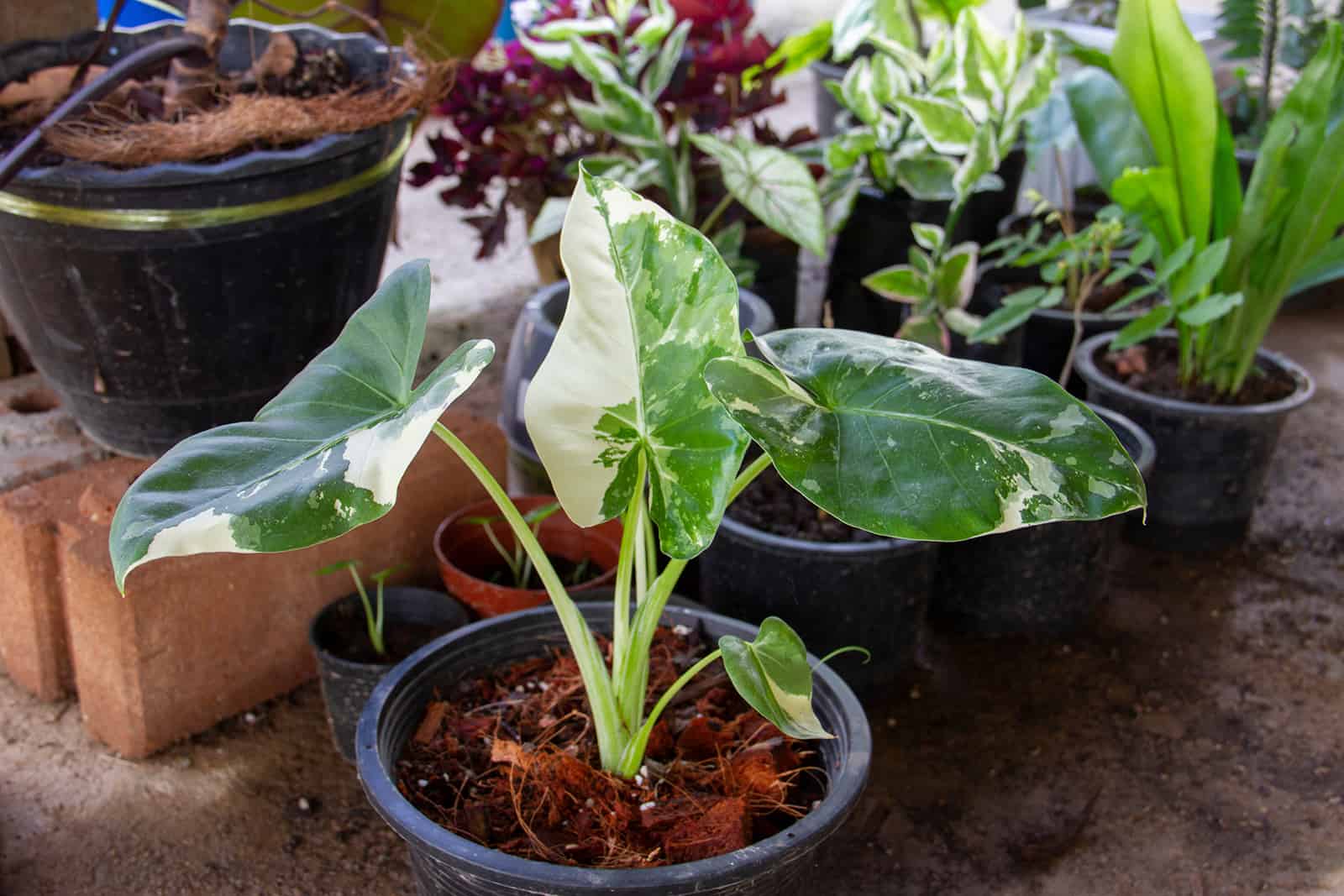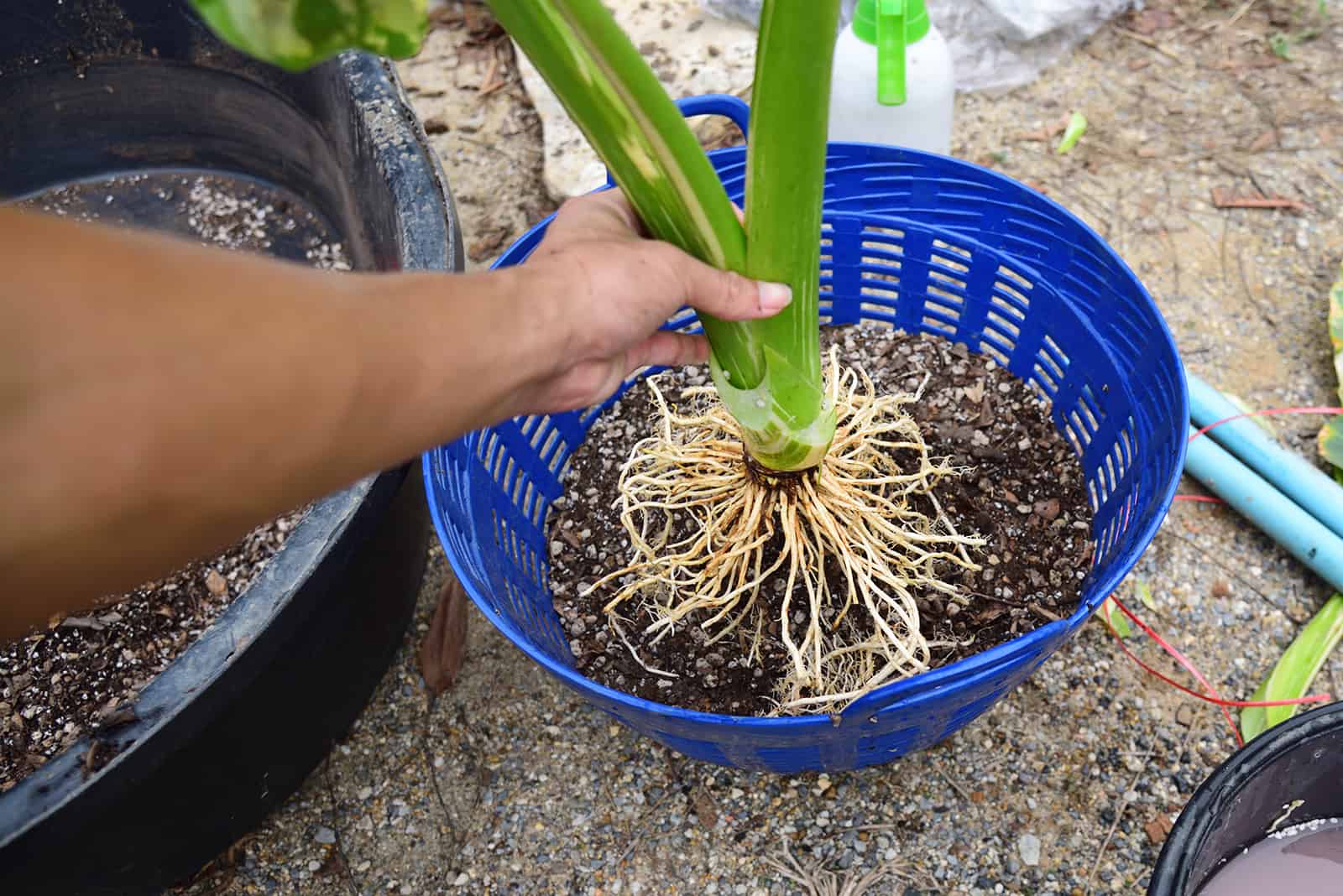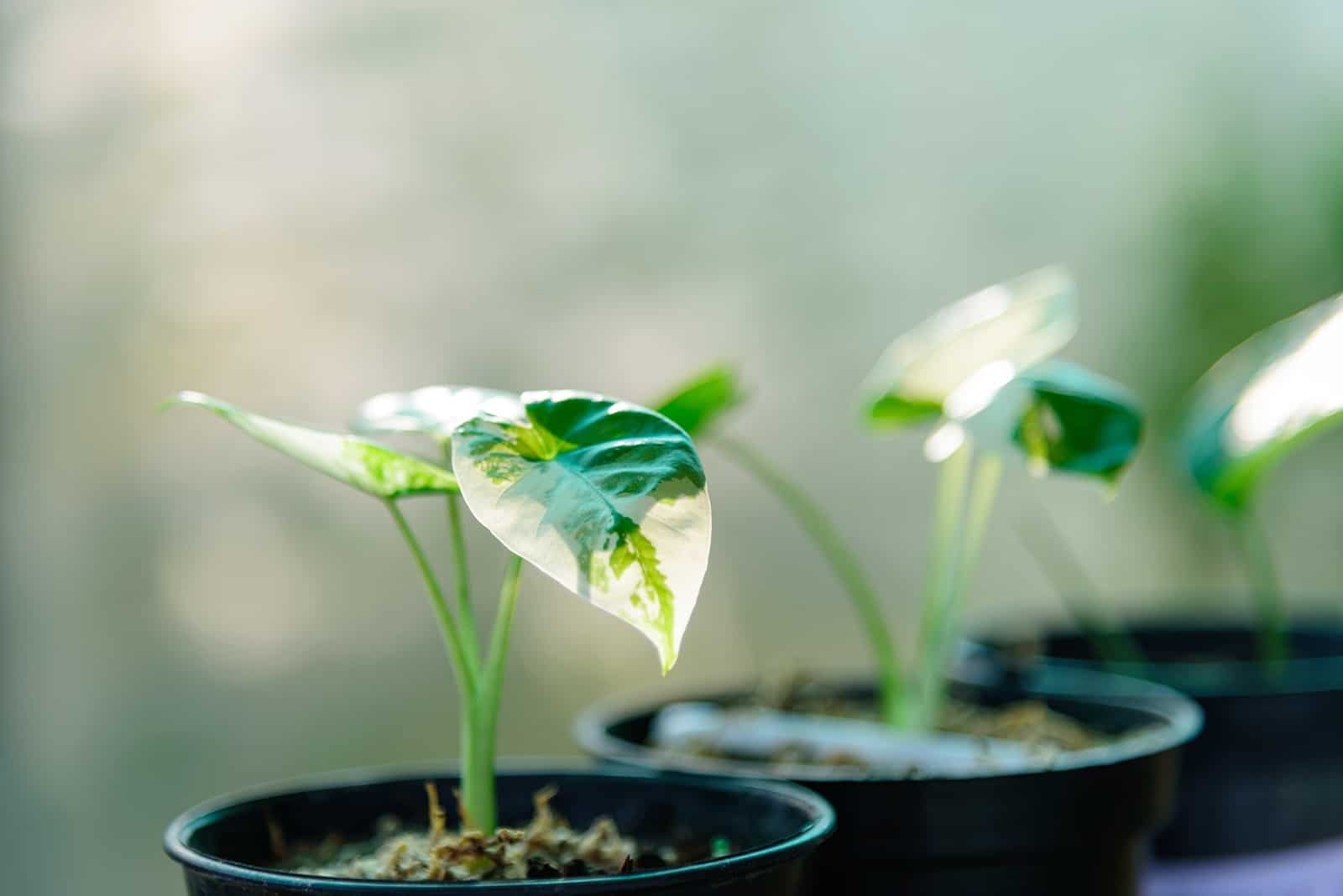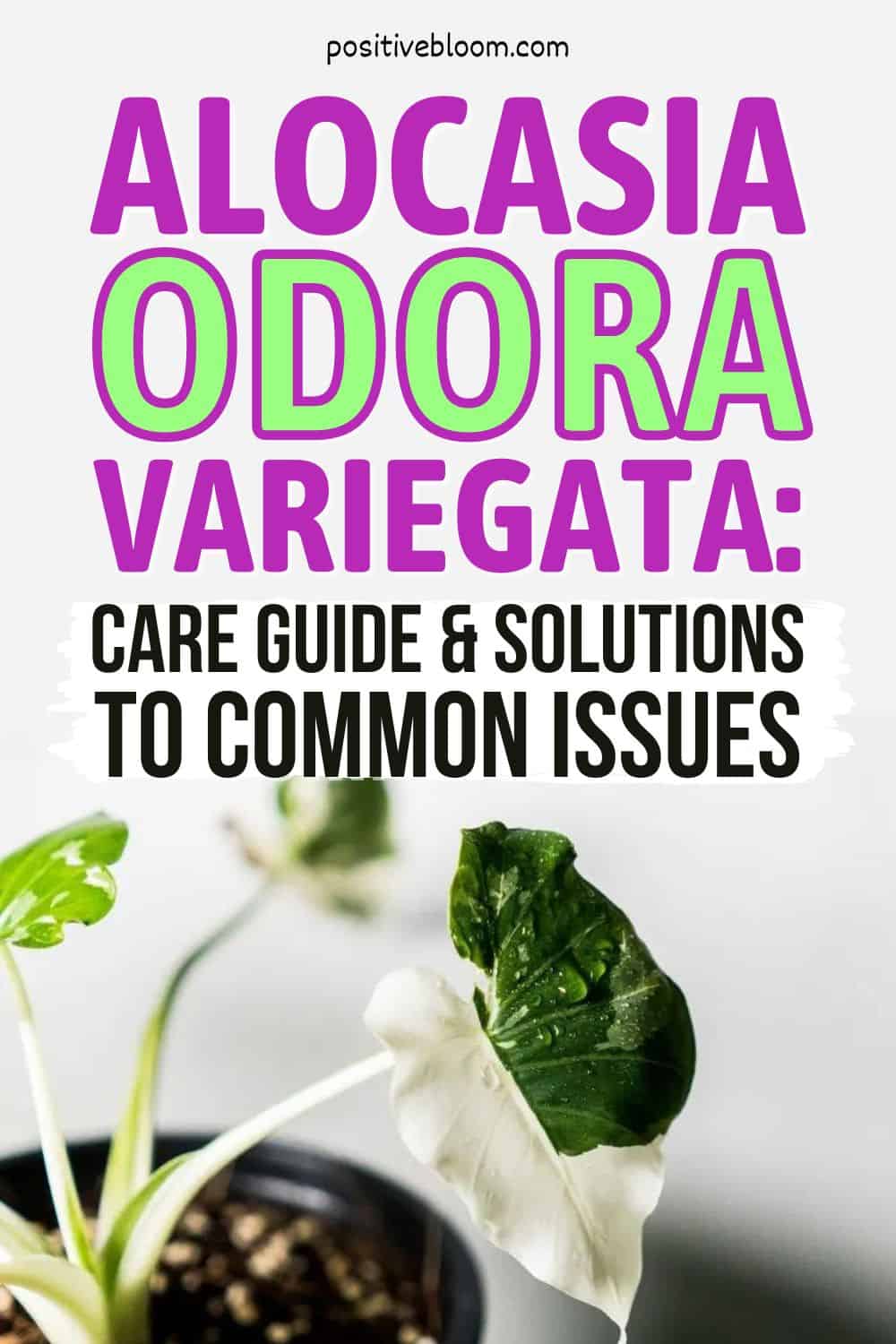The Alocasia Odora Variegata is a mesmerizing tropical plant that has become a popular houseplant!
Also known as Elephant’s Ear, the Alocasia Odora Variegata is a member of the Araceae family, which has about 80 species that grow in all different shapes and sizes.
There are so many fantastic options to choose from, and each plant is unique in its own way, so you can’t go wrong with any plant from this family!
If you decide to go for an Elephant Ear plant, you will definitely enjoy growing and taking care of it to help it grow its special variegated leaves.
This is a perfect indoor plant for gardener newbies as it’s low-maintenance and doesn’t have any special requirements.
Read on to learn everything you need to know about growing and taking care of this delightful plant!
What is an Alocasia Odora Variegata?
The Alocasia Odora Variegata is a cultivar of Alocasia Odora, and it produces leaves with beautiful white variegations, which is why it’s also referred to as “Albo Variegata” and “Variegated Elephant Ears”. However, its scientific name is Alocasia
Macrorrhiza Variegata — that’s a lot of names for just one plant, I know!
To make things clearer, take a look at this classification table:
[table id=125 /]This plant originates from the beautiful tropical and subtropical regions of Eastern Australia and Asia. Nowadays, you can find it almost anywhere as low-maintenance plants tend to become quite popular among plant enthusiasts!
This variegated Alocasia odora is often referred to as a dwarf plant, but that’s not completely true.
This plant tends to grow about 8 feet tall in the proper conditions, but it usually grows about 3 feet tall as it will grow according to the environment with which it’s provided.
For instance, if you are growing your Alocasia plant in a small container, it won’t have enough space to grow and develop, therefore it will stop growing after it has reached a certain size.
On the contrary, if you provide it with enough space to grow tall and wide, it can end up being 8 feet tall and 4 feet wide!
Leaves And Stems
The mesmerizing leaves are why these plants are so popular! Their eye-catching form will grab the attention of anyone who lays eyes on them. I often get lost in the contrasting colors; it’s a kind of therapy for me.
The Alocasia Odora Variegata has large dark green leaves with white variegations. They get even more appealing, as each leaf has its own unique variegations shaped like a heart!
Mother Nature is truly the best artist! 🙂
You won’t have to worry about the leaves falling off during the colder season, as they will stay the same throughout the year. This is a well-known feature of almost all the succulents out there.
The sturdy stems provide great support for these large leaves, although they aren’t as praiseworthy as the camouflage pattern leaves.
In addition to all of these features, this plant also has fragrant flowers that bloom during spring and summer, making the plant look even more appealing!
Growing Habits
New plants usually take 2 to 3 months to mature, and they grow to about 3 feet tall. Your plant will continue developing if it has enough space.
The Albo Variegata is also an evergreen plant, which means that it will continue growing all year around. However, they tend to go dormant during the winter.
Alocasia Odora Variegata Plant Care Guide
As we previously mentioned, this plant is low-maintenance and has pretty basic plant care guidelines. Nonetheless, there are certain conditions that must be met in order to keep this plant happy and healthy!
Let’s go through a step by step elephant ear plant care guide.
1. Soil Requirements
The Alocasia Odora Variegata thrives in well-draining and loose soil. It prefers acidic to neutral soil, with a pH from 5.6 to 7.5.
Bear in mind that you always have to test the soil before planting so you can see the pH. The most suitable soil is loamy, however you can always buy appropriate potting mix for your Aroid plant.
The potting mix should contain perlite, peat moss, and bark. You can try and make your own potting mix, just be sure that the soil is not either too sandy or heavy and that it retains moisture well.
As this is an expensive plant (it can go for up to $250 on Etsy), I suggest you invest in high-quality soil as it is such an important part of plant care. There’s no point spending all that money on the plant just to skimp on the soil.
2. Water Requirements
The Albo Variegata likes to have constantly moist soil, which would be soil that is neither too wet nor too dry. This means it can be hard to determine a regular watering schedule as a lot of different factors affect water requirements, such as temperature and humidity.
The best thing to do is check the soil before watering. You can simply use your finger to see if the top 2 inches of the soil have dried out, and if so, then it is time for watering! If the soil is still slightly moist, I would suggest you wait a few days to water it.
I water my Alocasia once a week, however my friend who lives in a different country has to water it twice a week, and sometimes even 3 times!
This is because he lives in a different climate, which proves you can’t actually know when to water your Alocasia plant other than by checking the soil.
Be aware that overwatering can easily cause root rot, and this infectious disease will likely completely ruin your plant!
3. Light Requirements
When it comes to the light requirements of an Alocasia Odora Variegata, it actually depends on the variegation of the leaves.
By that, I mean that if the leaves have more white patches than green ones, it will require a lot more bright and indirect light as there is no chlorophyll in the white patches.
These white patches can’t perform photosynthesis, so the green parts must do all that hard work alone!
Photosynthesis is necessary for plants to produce energy, and if the leaves were all covered in white patches then the plant wouldn’t have enough energy and nutrients for survival.
The general rule is that they love bright indirect light, however they can tolerate a few hours of direct sunlight either late in the afternoon or early in the morning.
Don’t put your Albo plant in a place that gets direct sunlight throughout the whole day as it may burn the leaves and cause them to lose variegation.
If you put this plant in a room without enough indirect or direct sunlight, then I suggest you use artificial grower lights to compensate for the missing light.
Nonetheless, the best placement for your Alocasia Odora Variegata would be in an east-facing window!
4. Temperature Requirements
As these tropical plants originate from regions of Eastern Australia and Asia, the most optimal temperature would be similar to these areas, and temperatures are pretty high out there!
The temperatures in these tropical areas usually range from 75 to 80 degrees Fahrenheit, although your Alocasia Odora Variegata is more adaptable than other tropical plants and can survive temperatures ranging from 55 to 60 degrees Fahrenheit.
Bear in mind that this is not a frost-hardy plant, and can actually freeze to death if left in significantly low temperatures for too long. You’d be better off taking your Albo Variegata indoors during the colder seasons!
If your plant is constantly exposed to lower temperatures, it will first go dormant and then the leaves might start falling off, which will ruin the whole plant. This includes cold drafts from open windows, air conditioners, and cooling fans.
5. Humidity Requirements
These tropical plants absolutely thrive in high humidity, which is the reason it can sometimes be tricky to grow tropical houseplants indoors.
For this specific tropical beauty, the recommended humidity levels are 70%, although your Alocasia might thrive in even higher humidity! You should avoid humidity levels less than 70% as it may affect the overall health of the plant, and if you notice that leaves are curling, you should probably boost the humidity in your home.
There are several ways you can increase humidity levels in your home. For instance, you can buy a humidifier, which is probably the easiest option.
If you don’t want to go down the humidifier route, then you could always mist your plant. Misting is usually done in the morning by spraying tepid water on the surface and underside of the leaves.
Another thing that you can do to boost humidity is create a pebble tray. You can do this by adding pebbles to a tray and pouring water in. The Pebble tray is placed underneath so that when the water evaporates it goes straight to the plant.
Finally, you could also put your Alocasia Odora Variegata in the bathroom as it’s the most humid room in most houses. Do bear in mind that your bathroom would need to have a window as a source of indirect light for your plant.
6. Fertilizer Requirements
This rare plant is not a heavy feeder, so it doesn’t need that much fertilizing. It should only be fertilized in the growing season, which is from spring to summer. As the Alocasia enters dormancy during winter, there is no need for fertilization.
You can use either liquid fertilizer or granular in small doses, it’s up to you, but in both cases you will have to apply it once a month during the growing season.
If you decide to use liquid fertilizer, make sure to spray it 6 inches away from the plant. Any closer and it can actually burn the leaves and roots, which you definitely want to avoid with this plant!
I would recommend you use a nitrogen-rich fertilizer as nitrogen encourages the growth of new leaves. The best option would be the NPK formula, which contains equal amounts of nitrogen, potassium, and phosphorus.
I would also suggest you invest in a high-quality fertilizer. This is a high-quality plant, and it deserves a high-quality fertilizer! Avoid over fertilizing your plant because the built up chemicals in the soil can affect its overall health.
7. Repotting
The Alocasia Odora Variegata should be repotted once a year, preferably into a larger pot. The pot has to have drainage holes at the bottom for proper drainage, and you should prepare adequate potting mix for your plant.
If you recall, the Albo Variegata prefers well-draining soil that is constantly moist. Sometimes soil can be too compact, which means there’s no proper air circulation, so you should just poke holes in the plant to allow for aeration.
What is the best container for an Alocasia Odora Variegata?
These plants are a type of dwarf plant, which means they won’t need large pots for their roots and shoots. When you are repotting your Alocasia plant, make sure to buy a new pot that is at least an inch larger than your previous one.
If you notice any roots coming out of the drainage holes, it’s usually an indicator that your plant needs a lot more space for its roots, so you might as well buy a pot that is about 2 or 3 inches larger than the previous one.
When it comes to the material, you can choose between terracotta, ceramic, or any other heavy material. You will need it to support the plant’s growth as it tends to get quite big.
It feels like I have told you about drainage holes a million times, however it’s super important that your Alocasia grows in a pot with drainage holes, so here we are again!
8. Pruning
Pruning is a bit different with an Alocasia Odora Variegata compared to most other indoor plants. As they go dormant during the winter, they won’t grow new leaves, which means there won’t be anything that needs to be pruned.
However, you should get rid of any damaged or dead leaves at the beginning of the growing season to make enough space to grow new leaves.
If you notice any significant discoloration of the leaves, it might be an indication of infection, so immediately remove that leaf to prevent spreading to the others.
Alocasia Odora Variegata Propagation
The Albo Variegata is an expensive and rare plant, so you should definitely propagate it to get more. You could even sell it or gift it to a friend!
If anything goes wrong with your plant, you won’t have to worry about spending lots of money on a single plant again because you have already propagated another.
Before you start propagating this plant, you must be aware that any completely white leaves are actually baby leaves, so if your plant has more white leaves than green ones, there won’t be enough green leaves to conduct photosynthesis and sustain the plant after it has been propagated.
Always make sure that you propagate the plant when it has almost equal amounts of green and white propagation on its leaves.
The best time for propagation would be early spring because your plant didn’t grow during winter, so there aren’t any baby leaves that could affect the propagation process.
It is recommended to perform propagation when repotting to kill two birds with one stone.
This plant is propagated by separating rhizomes and then putting them in a new pot. It is a pretty straightforward process that shouldn’t cause any damage to the mother plant. You will get a new and healthy baby plant after you’re done!
To successfully propagate an Alocasia Odora Variegata, follow these steps:
1. Make sure to water your Alocasia thoroughly a day before propagating because it is easier to work with soil that isn’t too compact.
2. The first step of propagation is taking the plant out of its pot and then removing the soil.
3. Investigate the root ball and start separating rhizomes that are suitable for propagation. Make sure to cut only rhizomes and not do any harm to the rest of the roots.
4. The mother plant should be placed back into the soil. You can place it in a new pot if you are repotting at the same time.
5. Put the rhizomes in a pre-prepared soil and make sure they stand upright. Add pressure around it to prevent it from falling to the side.
6. Water it thoroughly and stick to the plant care guide we provided. It all applies to your new plant as well.
If you are more into following visual instructions, then watch out this video:
How can you tell if the propagation was a success?
If you planted the rhizomes correctly and stuck to the appropriate plant care guide, you will notice little sprouts growing after a few weeks!
Continue watering your new plant, and then start fertilizing it. The new leaves will quickly develop from the little sprouts, and the whole plant should establish soon.
Common Problems With Alocasia Odora Variegata
The Albo Variegata is not too susceptible to various pests and diseases, which sounds great before you find out the reason, which is its toxicity! There is a risk of getting poisoned if you ingest this plant.
I’m sure you don’t go around eating houseplants, but it can be difficult to explain that to kids and pets!
Even though it’s toxic, the Alocasia Odora Variegata is prone to some pests like mealybugs, spider mites, scales, and aphids, as well as some bacteria.
As well as this, the leaves may start changing due to improper conditions, such as over or underwatering, over fertilizing, insufficient sunlight, etc.
Toxicity
Unfortunately, this rare plant is toxic and harmful if ingested. The toxicity comes from crystals called calcium oxalate, which cause swelling and inflammation of the tongue, mouth, and throat. This leads to stomach aches and severe pain.
It can cause a painful rash if it touches the bare skin, which is why you should always wear gloves when propagating or repotting this plant.
In addition to this, certain bacteria can also invade the leaves of your Alocasia Odora Variegata. This is another reason you should keep pets and little ones away from your Alocasia houseplant.
Pests & Diseases
As we previously mentioned, your precious plant is prone to certain pests and diseases. This is when the toxicity comes in handy, as it drives away many pests and insects.
However, some pests like scales and spider mites simply don’t care and attack anyway.
Scales
If you find anything sticky on your plant, you’re probably dealing with scales, which produce sticky honeydew that attracts ants.
You can get rid of them by dipping cotton in rubbing alcohol and gently rubbing it onto the leaves, which is where the scales reside.
Spider Mites
If your plant begins to act strangely in the winter, then spider mites are a likely culprit as they attack during the colder months.
Leaf showers and increased humidity levels may prevent them from infiltrating.
You can get rid of them quickly using neem oil or rubbing alcohol. Alcohol is quite severe, so we only recommend using it in an emergency.
You can also use soap solutions to get rid of these annoying pests.
However, the greatest remedy is keeping the bugs away in the first place, which you can accomplish by spraying insecticide on the leaves every now and then.
Root Rot
Root rot is also a common issue with an Alocasia because it can be tricky to determine when you need to water your new houseplant.
If you have been watering your plant quite frequently, and you notice yellowing of the leaves and the soil starting to smell kind of funny, then you are probably dealing with root rot.
Root rot is a fungal infection caused by overwatering, and it can be deadly for your Alocasia.
If you suspect that your plant might have root rot, then you should take it out of the pot, remove all the damaged roots, and then put it in a new pot filled with appropriate soil.
Rust
Another fungal infection that can cause problems is rust, which is known for leaving red and brown spots all over the leaves similar to rusty metals, hence the name.
It can occur for a few reasons: either your plant doesn’t have proper temperature and humidity levels, or it isn’t getting enough sunlight.
The logical solution would be to put it in a place with lots of light, however this will only make the disease progress much faster and eventually kill your plant.
The best way to deal with rust is to cut off any damaged leaves. You must also leave the plant to completely dry out before watering it again.
Bacteria Xanthomonas
You may also see an invasion of Xanthomonas bacteria, which causes dark lesions on the leaves and occasionally a yellow circle around it.
You could use copper-containing fungicides or bacterial sprays to treat it, although the best method is simply cutting off the infected leaves.
Pro tip: If you notice any discoloration or spots on the leaves of your Alocasia Odora Variegata, immediately remove them to prevent spreading. It would also help to keep your plants separate from one another in case of pest infestation.
Leaves Changing Color
If your Alocasia plant is either receiving not enough or too much light, the color of its leaves will probably change. If you notice paling or browning of the leaves, then the issue might be inadequate lighting.
Too little light will make the leaves appear much paler, and they may even lose their variegations, while too much direct sunlight can burn the leaves.
Another reason might be watering issues. For instance, if the leaves are starting to look yellowish, then you are probably overwatering or underwatering your plant. Which one depends on your watering schedule.
If you have done everything properly, then the issue might be improper temperature. Your plant could either be too hot or too cold, or even subject to constant fluctuations of temperature.
Leaves Falling Off
Oh no! You bought this expensive plant for its beautiful variegated leaves, and now they have started falling off! What could be the cause of this?
Well, inadequate growing conditions are the main reason the leaves of houseplants start falling off. For instance, you could be over watering your plant, which makes the soil constantly soggy.
The issue could also be improper drainage. Even though your Alocasia plant loves moist soil, it doesn’t enjoy having soggy soil all the time.
This is why it’s important to always check if the topsoil has dried out, and only water it then. Adequate watering is extremely important.
Frequently Asked Questions
1. What plants are similar to the Alocasia Odora Variegata?
The Albo variegata is not the only plant with white patches. For instance, there is a type of Monstera plant called Monstera deliciosa Albo that also has white spots on its leaves.
There are also a few variegated Philodendron species that would go well with your Alocasia plant.
As well as these types, there are a few plants from the genus Alocasia usually grown together with the Alocasia Odora Variegata, such as Jewel Alocasia, Alocasia Okinawa Silver and Black Velvet. These match perfectly together!
Alocasia and Colocasia often get mistaken for one another, though they are two completely different plant species!
2. How are the leaves of the Alocasia Odora Variegata different to those of other Alocasia?
This rare plant is desired mainly because of the variegations of its leaves. Not only are the leaves heart shaped, but they also have different white and green patches that give them a marble appearance.
These leaves are quite large compared to other types of Alocasia, and they are evergreen, which means that they are there all year round!
3. What color is the stem of the Alocasia Odora Variegata?
They have sturdy stems with a pale-green color, somewhere between white and green. Nonetheless, the stems usually don’t get much attention next to the mesmerizing leaves.
To Sum Up
The Alocasia Odora Variegata is truly one of the most beautiful houseplants I have ever seen! Seriously, they can make any room look much more aesthetically pleasing with their mesmerizing variegated leaves!
Even though it’s quite pricey, I think it’s totally worth buying. The watering might be kind of tricky, but the other requirements of this plant are quite easy to accomplish and make your plant healthy and happy.
The propagation is also pretty straightforward, and after successful propagation you will have two or more Alocasia Odora Variegata to either gift or sell to make money!
Due to its toxicity, it is resistant to many pests and insects, so you won’t have to worry much about them ruining your plant, but be on the lookout for spider mites and mealybugs.
Until next time!
Like this post? Share or pin it for later!

